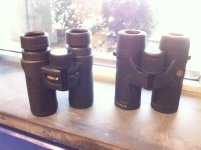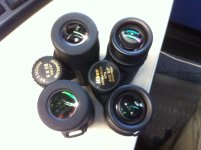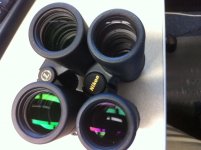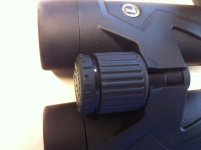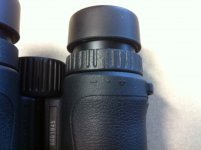FrankD
Well-known member
If you have been reading along in either the Nikon or Leupold subforums you know that I recently had the opportunity to compare a variety of 8x30-something format roofs down at Cape May a couple of weekends ago. At the time I became extremely enamored with the Monarch 7 because of both its handling and its optical performance. Well, I finally caved a few days ago and ordered one from B and H Photo. It came two days ago and I have been comparing it to the Leupold Mojave 8x32 ever since. SteveC also now has both of these binoculars in his possession. He pm'ed me his initial impressions and they pretty much correlate with my own experiences. I leave it up to him to chime in with those thoughts at some point after this is posted.
One disclaimer before you read further. The specific Nikon unit that I have seems to be suffering from the same lack of internal blackening on a few of the internal components. This can, and does, affect a variety of optical areas but, in my opinion, the worst is contrast. Keep that in mind as you read the rest of this post.
On paper the two binoculars seem quite evenly matched.
Nikon Monarch 7
Magnification 8.0x
Objective Lens Diameter 30 mm
Angle of View 8.3° (actual)
Field-of-View 436.75' @ 1000 yd / 145 m @ 1000 m
Minimum Focus Distance 6.56' / 2 m
Eye Relief 15.1 mm
Interpupillary Adjustment 56 - 72 mm
Weight 15.34 oz / 435 g
Leupold Mojave
Magnification 8.0x
Objective Lens Diameter 32 mm
Angle of View 8.0° (actual)
Field-of-View 420' @ 1000 yd / 140 m @ 1000 m
Minimum Focus Distance 7' / 2.13 cm
Eye Relief 16 mm
Interpupillary Adjustment 58 - 74 mm
Weight 17 oz / 482 g
Initial Impressions only.....
Ergonomics:
To cut to the chase, I like both. I have had the Mojave for a longer period of time and have grown accustomed to how it feels. The only issue with them that I have with them in this area is the strap lug. If it were a half inch closer to the oculars then it would be excellent.
Having said that I will say that I definitely prefer the Monarch 7. Not just how they feel in my hands though but also how they feel up to my eyes. Though I don't find the wider diameter eyecups of the Mojave an issue I do find the Nikon's narrower diameter eyecups and larger oculars more enjoyable. They tend to allow for more of an immersive experience. I also find the texture of the Nikon's rubber armoring more pleasing. It has a bit more of a cushion to it despite the fact that it appears thinner in diameter in comparison to the Leupold. The focusing tension also has more a solid, controllable feel to it.
Optical Performance:
These two binoculars are more alike than not in the grand scheme of things. Considering the similarity in their physical dimensions and their listed specs I believe they would have to be. Both offer generous sweet spots with very good performance overall inside of the sweet spot. Both suffer from off axis performance issues but not to any great degree. So, if I had to break it down based on the various optical attributes it would go something like this....
All characteristics are "apparent" in nature.
Brightness: Tough call. Probably a tie. At times I get the impression the Leupold is brighter but then at other times I can't tell a difference. I need more time to evaluate them to get a true impression.
Contrast: Because of the issue mentioned earlier I would have to give this one to the Leupold. Color saturation is excellent. Blacks are really black and whites are really white. Even when trying to discern differences in color at great distances the Leupold shines. This subsequently leads to an increase in perceived sharpness but I don't want to get to that yet. The Leupold does not appear to have "poor contrast" but rather just isn't up to the level of the Leupold.
Sharpness: Again the nod has to go to the Leupold. As a test for this I started looking at individual trees and rock outcroppings on a mountain ridge about 3/4 of a mile west of my location. With the Leupold I feel like I can look at ever nook and cranny there. Not so much with the Nikon.
Sweet Spot Size: My "impression" is that the Nikon is slightly better than the Leupold...or maybe I should say that the transition from the sweet spot to the edge of the field of view is more gradual in the Nikon. I can sense the more abrupt change in the Leupold though even the Leupold isn't even down to the level of fair in this area. It is actually quite good.
CA control: I would call it a tie here as well. Though the Nikon sports ED glass the Leupold controls CA very well within the sweet spot. If you handed me both and asked me to pick out which one had the ED glass and which one didn't I probably wouldn't be able to tell you. I am going to try to push them in this area as time passes. Maybe then I might see more of a difference between them.
All I can think of for now. I will leave you with some comparison pics.
One disclaimer before you read further. The specific Nikon unit that I have seems to be suffering from the same lack of internal blackening on a few of the internal components. This can, and does, affect a variety of optical areas but, in my opinion, the worst is contrast. Keep that in mind as you read the rest of this post.
On paper the two binoculars seem quite evenly matched.
Nikon Monarch 7
Magnification 8.0x
Objective Lens Diameter 30 mm
Angle of View 8.3° (actual)
Field-of-View 436.75' @ 1000 yd / 145 m @ 1000 m
Minimum Focus Distance 6.56' / 2 m
Eye Relief 15.1 mm
Interpupillary Adjustment 56 - 72 mm
Weight 15.34 oz / 435 g
Leupold Mojave
Magnification 8.0x
Objective Lens Diameter 32 mm
Angle of View 8.0° (actual)
Field-of-View 420' @ 1000 yd / 140 m @ 1000 m
Minimum Focus Distance 7' / 2.13 cm
Eye Relief 16 mm
Interpupillary Adjustment 58 - 74 mm
Weight 17 oz / 482 g
Initial Impressions only.....
Ergonomics:
To cut to the chase, I like both. I have had the Mojave for a longer period of time and have grown accustomed to how it feels. The only issue with them that I have with them in this area is the strap lug. If it were a half inch closer to the oculars then it would be excellent.
Having said that I will say that I definitely prefer the Monarch 7. Not just how they feel in my hands though but also how they feel up to my eyes. Though I don't find the wider diameter eyecups of the Mojave an issue I do find the Nikon's narrower diameter eyecups and larger oculars more enjoyable. They tend to allow for more of an immersive experience. I also find the texture of the Nikon's rubber armoring more pleasing. It has a bit more of a cushion to it despite the fact that it appears thinner in diameter in comparison to the Leupold. The focusing tension also has more a solid, controllable feel to it.
Optical Performance:
These two binoculars are more alike than not in the grand scheme of things. Considering the similarity in their physical dimensions and their listed specs I believe they would have to be. Both offer generous sweet spots with very good performance overall inside of the sweet spot. Both suffer from off axis performance issues but not to any great degree. So, if I had to break it down based on the various optical attributes it would go something like this....
All characteristics are "apparent" in nature.
Brightness: Tough call. Probably a tie. At times I get the impression the Leupold is brighter but then at other times I can't tell a difference. I need more time to evaluate them to get a true impression.
Contrast: Because of the issue mentioned earlier I would have to give this one to the Leupold. Color saturation is excellent. Blacks are really black and whites are really white. Even when trying to discern differences in color at great distances the Leupold shines. This subsequently leads to an increase in perceived sharpness but I don't want to get to that yet. The Leupold does not appear to have "poor contrast" but rather just isn't up to the level of the Leupold.
Sharpness: Again the nod has to go to the Leupold. As a test for this I started looking at individual trees and rock outcroppings on a mountain ridge about 3/4 of a mile west of my location. With the Leupold I feel like I can look at ever nook and cranny there. Not so much with the Nikon.
Sweet Spot Size: My "impression" is that the Nikon is slightly better than the Leupold...or maybe I should say that the transition from the sweet spot to the edge of the field of view is more gradual in the Nikon. I can sense the more abrupt change in the Leupold though even the Leupold isn't even down to the level of fair in this area. It is actually quite good.
CA control: I would call it a tie here as well. Though the Nikon sports ED glass the Leupold controls CA very well within the sweet spot. If you handed me both and asked me to pick out which one had the ED glass and which one didn't I probably wouldn't be able to tell you. I am going to try to push them in this area as time passes. Maybe then I might see more of a difference between them.
All I can think of for now. I will leave you with some comparison pics.




